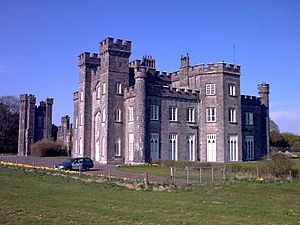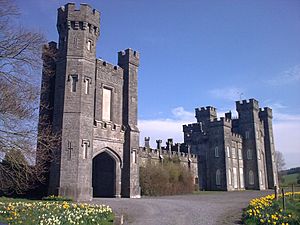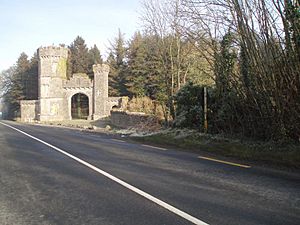Knockdrin facts for kids

Knockdrin (Irish: Cnoc Droinne) is a small area in County Westmeath, Ireland. It's about 5.6 kilometers (about 3.5 miles) northeast of Mullingar. This area is famous for being home to the Westmeath Hunt and, most importantly, Knockdrin Castle. The main road connecting Mullingar to Castlepollard (the R394) goes right through Knockdrin.
Contents
What Does Knockdrin Mean?
The name Knockdrin comes from the Irish language words Cnoc Droinne. This means 'hill of Drin'. People believe it's named after a hill on the castle estate. There's also a small lake nearby called Lough Drin, which shares the name.
The Irish name for the wider area is Muine Liath, which means 'grey thicket'. In English, this name is often written as Monilea.
Knockdrin Castle: A Historic Home
Knockdrin Castle is a beautiful old building. It looks like a castle from a fairy tale, with its tall towers and fancy details. This style is called neo-Gothic, which means it was built to look like older Gothic castles.
The castle you see today was built for Sir Richard Levinge, who was the 6th Baronet of his family. This happened around the 1810s. Before this castle, an older house called 'High Park' stood on the same spot. Some parts of the old gate might even be from that earlier house!
Experts say Knockdrin Castle is one of the best examples of a "picturesque castellated country house" built in Ireland during the early 1800s. It still looks much like it did when it was first built. The estate also has many other buildings, including parts of a very old tower house from around 1550.
While some people thought the famous architect Richard Morrison designed the castle, it seems the final plans were actually by James Shiel. He was an assistant to Francis Johnston, another well-known architect of that time.
For many years, until late 2020, the castle was home to the von Prondzynski family. Professor Ferdinand von Prondzynski was the last family member to own it. In December 2020, a couple named Noel and Valerie Moran bought the castle and most of the land. Professor von Prondzynski still owns a smaller part of the property.
The Castle's Past
Before the current castle, a smaller Norman castle stood on the estate. Locals sometimes called it 'King John's Castle'. Sadly, it was destroyed by fire in the early 1700s.
The Levinge family arrived in Ireland in the late 1600s. The first Sir Richard Levinge was a very important judge. He was part of a group appointed by the British Crown to sort out land ownership issues in Ireland after several wars. Sir Richard used his position to buy the Knockdrin Estate from the Tuites, who were the previous owners. At that time, the estate was huge, covering over 12,000 acres (about 48.5 square kilometers)! Today, it's much smaller, around 1,000 acres (about 4 square kilometers).
During the Irish War of Independence, a very famous person, Winston Churchill, stayed at the castle. The bedroom he used is now known as the Crown Bedroom.
During World War II, the Irish Army used the castle to house soldiers. They stayed there until 1945, when they gave the castle back to the Levinge family. The Levinges owned Knockdrin until 1946.
In 1946, the estate was sold to Paddy Dunne-Cullinan. He lived there until 1961, when he sold it to Hans Freiherr von Prondzynski from Germany.
By 2020, the castle had many grand rooms, including twelve bedrooms, five bathrooms, a beautiful oak staircase, and large reception rooms like a dining room, ballroom, and library. It also came with woodlands and a small lake. While the castle was in good structural shape, it needed some modern updates. The new owners, Noel and Valerie Moran, plan to do a lot of restoration work on the castle and its other buildings.
Other Castles in County Westmeath
- Ballinlough Castle
- Clonyn Castle (also known as Delvin Castle)
- Killua Castle
- Tullynally Castle
- Tyrrellspass Castle



